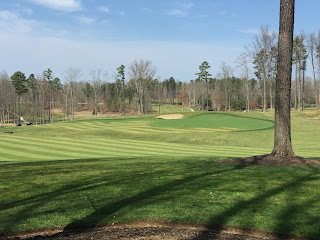That being said, we began spraying round-up last Thursday on our first golf hole. To speed up the kill, we added a small rate of Reward to the mix. Below you will see pictures that walks you through the initial steps of our project.
We do ask that our members be aware of the WHITE paint lines and ORANGE marking flags. If you see these areas, please assume that there is newly applied herbicide in those areas. Feel free to treat those areas as ground under repair. Aside from great assistance from our professional staff and caddies, we will post a turf manager near the sites of herbicide application to further communicate which areas to avoid. Thanks for your patience as we make strides to restore our primary rough.
Our First step is to locate the weeds that we wish to eradicate. From there, we designate our target areas with white paint and orange pin flags.
Once identified and marked, the targeted areas are sprayed with round-up and dye. The dye is to help our applicator see where he has sprayed, but it is also an indicator for staff and players that an area has been treated with herbicide.
Once treated with round-up, we wait 5-7 days for the round-up to move throughout the grass plant.
Once we achieve kill, our staff begins sod cutting all of the sprayed areas.
Once these areas have been sod cut, our staff will use the combination of trailers, shovels, carts and our dingo to scoop up and remove the material. Later this week, 2 trucks of tall fescue will arrive and these areas will be re-sodded. Simultaneously, we have marked and sprayed our next 1/2 acre section and another 2 trucks of sod will arrive a week from today. We will repeat this process throughout the fall.























































